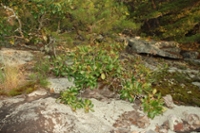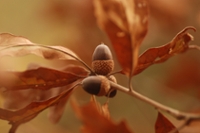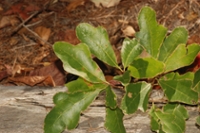Committee Members:
Patrick Thompson (chair): Auburn University Davis Arboretum
Wayne Barger: Alabama Department of Conservation and Natural Resources
John Manion: Birmingham Botanical Gardens
Michelle Reynolds: AL Glade Expert
Contact Point:
Patrick Thompson, Davis Arboretum. 101 Rouse Life Sciences Building
Auburn University AL, 36849-5407 thomppg@auburn.edu (334) 332.0283
The Flora of North America (Vol. 3) describes this Alabama endemic species as forming shrubs/small trees (up to ~20ft.). The plants are rhizomatous and have a scaly, brown bark. The typically three-lobed 3” long by 1.5” wide leaves are commonly oblanceolate to obovate with a slightly revolute margin and cuneate base. The upper surface of the leaf is dark, glossy green with the underside having silvery-gray stellate hairs.
Natureserve.org reports this species status as a G1S1, indicating the highest level of conservation concern at the state and global level. It is not federally listed and has no recovery plan. The species is vulnerable because of small population numbers and narrow habitat preference. The majority of historical records for the species have been limited to sandstone outcrops. Fortunately, these habitats are not well suited for forestry or development. Plants have been discovered in areas that have been developed indicating relictual populations may be wider distributed than originally believed. This project is intended to make specialist and the general public more aware of this rare, cryptic tree suited to survive in one of AL’s most punishing habitats.
This project is intended to make specialist and the general public more aware of this rare, cryptic tree suited to survive in one of AL’s most punishing habitats. Our records show infrequent mast years, and though it is a G1S1 species it is accessible, and sought by collectors. Anyone interested in growing this species can contact us for sources to purchase plants, guidance in sustainable collection practices, and to submit collection records.
Goals:
1. Maintain records of species distribution by collecting vouchers, and submitting them to state herbariums with the goal of having each population of this species represented therein.
2. Avoid loss of genetic diversity by advocating for protected sites, and public education initiatives.
3. Increase ex situ holdings by responsibly collecting acorns and distributing to appropriate public gardens willing to preserve them as part of their permanent collections.
4. Protect in situ populations through site cleanups, monitoring acorn production and collection, and maintaining collection records.
Accomplishments:
1. 3 counties added to species distribution on Alabama Plant Atlas, new populations documented.
2. Ex situ collections are increasing.
3. Hind’s Road Rock Outcrop purchased by the state's Forever Wild program.
4. A recent article in Alabama Gardener Magazine should help raise awareness.



